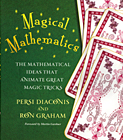- About MAA
- Membership
- MAA Publications
- Periodicals
- Blogs
- MAA Book Series
- MAA Press (an imprint of the AMS)
- MAA Notes
- MAA Reviews
- Mathematical Communication
- Information for Libraries
- Author Resources
- Advertise with MAA
- Meetings
- Competitions
- Programs
- Communities
- MAA Sections
- SIGMAA
- MAA Connect
- Students
- MAA Awards
- Awards Booklets
- Writing Awards
- Teaching Awards
- Service Awards
- Research Awards
- Lecture Awards
- Putnam Competition Individual and Team Winners
- D. E. Shaw Group AMC 8 Awards & Certificates
- Maryam Mirzakhani AMC 10 A Awards & Certificates
- Two Sigma AMC 10 B Awards & Certificates
- Jane Street AMC 12 A Awards & Certificates
- Akamai AMC 12 B Awards & Certificates
- High School Teachers
- News
You are here
Magical Mathematics: The Mathematical Ideas that Animate Great Magic Tricks

Publisher:
Princeton University Press
Publication Date:
2011
Number of Pages:
244
Format:
Hardcover
Price:
29.95
ISBN:
9780691151649
Category:
General
The Basic Library List Committee suggests that undergraduate mathematics libraries consider this book for acquisition.
[Reviewed by , on ]
John D. Cook
11/3/2011
If you wanted to find a perfect book on magic and mathematics, you might look for something written by Persi Diaconis and Ron Graham. The only thing more you might ask would be a preface by the late Martin Gardner. Magical Mathematics is precisely that book.
As the title suggests, Magical Mathematics is indeed a book about magic and mathematics. Not obvious from the title is that the book also contains a significant amount of biography, which we will say more of in a moment. The mathematics in the book is mostly elementary. The book is aimed at a popular audience, not professional mathematicians. However, Diaconis and Graham allude to much deeper mathematical connections that are not explicitly developed in their book.
All the magic in the book has mathematical explanations; none of the tricks depend on slight of hand or tricky equipment. But rather than simply giving dry, mathematical descriptions, each trick is presented with sample patter and notes on showmanship.
The mathematics and the magic are intertwined. Magic tricks suggest mathematical problems, and mathematical solutions suggest magic tricks. Sometimes an innovation on one side spurs an innovation on the other side.
In addition to instruction in magic and mathematics, Magical Mathematics tells stories of mathematical magicians, including some who influenced the authors. Chapter 7, for example, begins with a story from Diaconis’ childhood and ends with a story Graham’s. (The authors do not clearly identify themselves; it takes a little deduction to determine which is speaking when the book includes personal anecdotes.)
Magical Mathematics, like the careers of its authors, blurs the lines between “serious” and “recreational” mathematics.
John D. Cook is a research statistician at M. D. Anderson Cancer Center and blogs daily at The Endeavour.
Foreword ix
Preface xi
Chapter 1: Mathematics in the Air 1
Royal Hummer 8
Back to Magic 15
Chapter 2: In Cycles 17
The Magic of de Bruijn Sequences 18
Going Further 25
Chapter 3: Is This Stuff Actually Good For Anything? 30
Robotic Vision 30
Making Codes 34
To the Core of Our Being 38
This de Bruijn Stuff Is Cool but Can It Get You a Job? 42
Chapter 4: Universal Cycles 47
Order Matters 47
A Mind-reading Effect 52
Universal Cycles Again 55
Chapter 5: From the Gilbreath Principle to the Mandelbrot Set 61
The Gilbreath Principle 61
The Mandelbrot Set 72
Chapter 6: Neat Shuffles 84
A Mind-reading Computer 85
A Look Inside Perfect Shuffles 92
A Look Inside Monge and Milk Shuffles 96
A Look Inside Down-and-Under Shuffles 98
All the Shuffles Are Related 99
Chapter 7: The Oldest Mathematical Entertainment? 103
The Miracle Divination 105
How Many Magic Tricks Are There? 114
Chapter 8: Magic in the Book of Changes 119
Introduction to the Book of Changes 121
Using the I Ching for Divination 122
Probability and the Book of Changes 125
Some Magic (Tricks) 127
Probability and the I Ching 136
Chapter 9: What Goes Up Must Come Down 137
Writing It Down 138
Getting Started in Juggling 145 10 Stars of Mathematical Magic (and some of the best tricks in the book) 153
Alex Elmsley 156
Bob Neale 160
Henry Christ 173
Stewart James 181
Charles Thornton Jordan 189
Bob Hummer 201
Martin Gardner 211
Chapter 11: Going further 220
Chapter 12: on secrets 225
Notes 231
Index 239
- Log in to post comments




